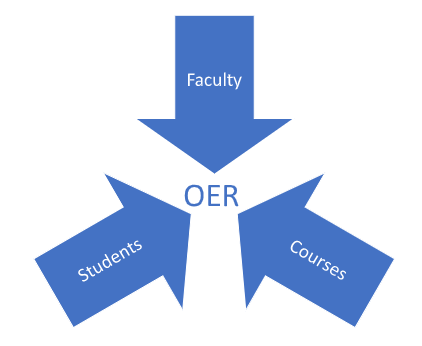OER can help us address challenges in 3 areas:
- Challenges for Faculty
- Challenging Courses
- Challenges for Students

Challenges for Faculty
For faculty, some common challenges are:
- Outdated Material
- Poor Textbook Fit
- Blackboard Integration
In the case of outdated material, OER can be used to replace outdated supplemental and multimedia resources with Creative Commons licensed video, interactive exercises, simulations and more. OER resources are more likely to meet Accessibility Standards then outdate material and, because of the nature of Creative Commons licensed work, can be remixed to meet new standards.
In the case of poor textbook fit, faculty can supplement the required text with OER text chapters, modules or other resources to fill gaps. Faculty can also remix two or more OER texts to create a textbook that matches their requirements as well as package personally created materials into OER.
Because of the remix/reuse aspects of OERs, Faculty can transform resources for use on Blackboard to enhance Blended and flipped classroom approaches and online courses.
Challenging Courses
Courses challenges: High risk and high drop courses
High risk courses are those key courses in a program where a student failure is likely to jeopardize graduation. These are often first problem-solving courses where theory must be applied. High drop courses can be identified in each program based on failure rates and withdrawals/drops during semester. Not only do High Drops impact graduation rates, but also result in students becoming off sequence, Eg, Special Students, Part-time students.
OER can be used with high risk and high drop courses by identifying and sharing supplemental materials for
- Areas of common confusion (student pain points)
- Demonstration of problem-solving steps, examples and case studies
- Self-study remedial resources
Challenges for Students
International students would benefit from OER textbooks and supplemental materials in:
- English and Communication courses
- Courses that highlight industry/field terminology – introductory courses
- General education courses
Domestic student groups such as mature students, low income students and first-generation students would benefit from the cost saving of 1st year introductory courses such as:
- General Science – Biology, Chemistry
- Math/Physics
- English/Communications
- General Education
Benefits of OER
For all students, OER represents:
- Cost savings
- Textbook access from Day 1
- Materials often more relevant to course and classroom expectations because of customization
- Ability to retain textbooks (and other materials) for reference
- Access to materials in a variety of formats and for use on a variety of platforms.
For St. Clair College, OERs can support our efforts in a number of areas.
- Learning: OER support better LEARNING - first day access to materials, relevant to course, increase in grades, decrease in drops, takes more courses
- Teaching: greater control over text, greater engagement with materials, transfer of high impact teaching methods, knowledge and expertise in related and new areas.
- Institutional reputation: OER can help institutions raise their profile on the educational landscape
- Social factors: OER also form part of the strategy to increase access to higher education for students from traditionally disadvantaged backgrounds or communities.
What can we do now?
We can begin to use OERs in our courses with varying levels of integration:
Level 1
- Replace outdated materials
- Add supplemental or remedial materials
Level 2
- Add companion textbook, chapters and other materials
- Add OER modules
- Adopt an existing OER textbook
Level 3
- Remix and adopt OER textbook
- Remix OER and incorporate into Blackboard
- Curate OER for blended or online course
- Create New OER textbook or module
How to find and combine OER
This short video from Florida State University provides an example of one faculty member combining existing OER into her new chapter on Metabolism.
Acknowledgment
This module was made possible with funding by the Government of Ontario and through eCampusOntario’s support of the Virtual Learning Strategy. To learn more about the Virtual Learning Strategy visit: https://vls.ecampusontario.ca.
Contributor:
- Irene Stewart, Retention Coordinator

This work is licensed Creative Commons Attribution Non-Commercial ShareAlike by St. Clair College, Centre for Academic Excellence and Quality Assurance unless otherwise noted.